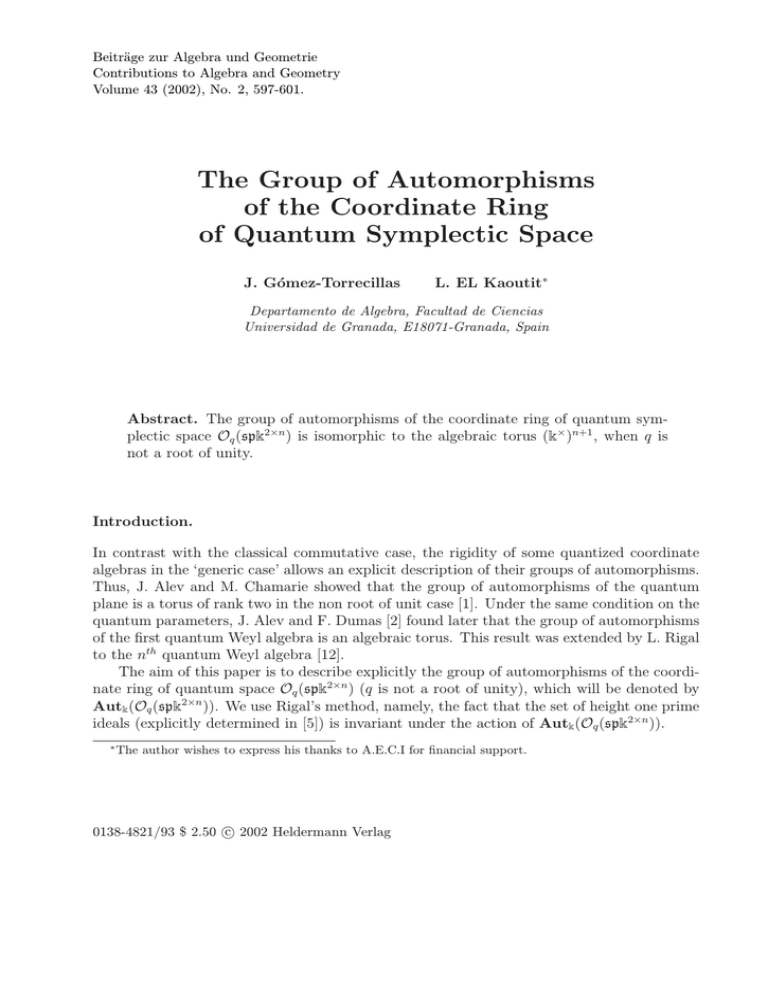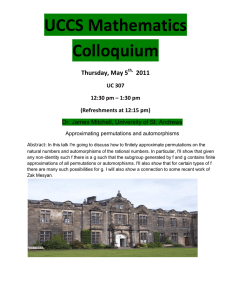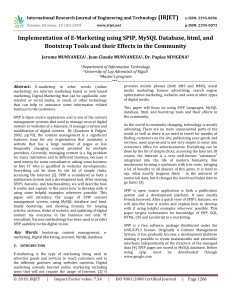Beitr¨ age zur Algebra und Geometrie Contributions to Algebra and Geometry
advertisement

Beiträge zur Algebra und Geometrie
Contributions to Algebra and Geometry
Volume 43 (2002), No. 2, 597-601.
The Group of Automorphisms
of the Coordinate Ring
of Quantum Symplectic Space
J. Gómez-Torrecillas
L. EL Kaoutit∗
Departamento de Algebra, Facultad de Ciencias
Universidad de Granada, E18071-Granada, Spain
Abstract. The group of automorphisms of the coordinate ring of quantum symplectic space Oq (spk2×n ) is isomorphic to the algebraic torus (k× )n+1 , when q is
not a root of unity.
Introduction.
In contrast with the classical commutative case, the rigidity of some quantized coordinate
algebras in the ‘generic case’ allows an explicit description of their groups of automorphisms.
Thus, J. Alev and M. Chamarie showed that the group of automorphisms of the quantum
plane is a torus of rank two in the non root of unit case [1]. Under the same condition on the
quantum parameters, J. Alev and F. Dumas [2] found later that the group of automorphisms
of the first quantum Weyl algebra is an algebraic torus. This result was extended by L. Rigal
to the nth quantum Weyl algebra [12].
The aim of this paper is to describe explicitly the group of automorphisms of the coordinate ring of quantum space Oq (spk2×n ) (q is not a root of unity), which will be denoted by
Autk (Oq (spk2×n )). We use Rigal’s method, namely, the fact that the set of height one prime
ideals (explicitly determined in [5]) is invariant under the action of Autk (Oq (spk2×n )).
∗
The author wishes to express his thanks to A.E.C.I for financial support.
c 2002 Heldermann Verlag
0138-4821/93 $ 2.50 598
J. Gómez-Torrecillas, L. EL Kaoutit: The Group of Automorphisms . . .
1. The quantum symplectic space
Let k be a field, and q a non-zero element in k which is not a root of unity. I. M. Musson
found [8, §1.1] that the coordinate ring Oq (spk2×n ) of the quantum symplectic space (cf.
[11, Definition 14] or [13, §4]) is the k-algebra generated by y1 , x1 , . . . , yn , xn satisfying the
following relations
yj xi = q −1 xi yj ,
xj xi = q −1 xi xj ,
2
yj yi = qyi yj (1 ≤ i < j ≤ n)
xj yi = qyi xj (1 ≤ i < j ≤ n)
2
i−1
P
xi yi − q yi xi = (q − 1)
q
i−l
yl xl
(1)
(1 ≤ i ≤ n)
l=1
By [9, Proposition 1.10] or [10, Example 6], Oq (spk2×n ) can be written as an iterated Ore
extension
R0 ⊆ R1 ⊆ · · · ⊆ Rn = Oq (spk2×n )
where R0 = k and Rk = Rk−1 [yk ; αk ][xk ; βk , δk ] for k ≥ 1, with
αk (xl ) = q −1 xl = βk (xl )
αk (yl ) = qyl = βk (yl )
βk (yk ) = q 2 yk
(1 ≤ l < k ≤ n)
(1 ≤ l < k ≤ n)
(1 ≤ k ≤ n)
k−1
P
δk (Rk−1 ) = 0, δk (yk ) = (q 2 − 1)
q k−l yl xl (1 ≤ k ≤ n)
l=1
Consider the elements Ωi =
Pi
l=1
q i−l yl xl (i ≥ 1). From [9, Lemma 1.3] we get
Ωi yk = q 2 yk Ωi , Ωi xk = q −2 xk Ωi (k ≤ i)
Ωi x k = x k Ωi ,
Ωi y k = y k Ωi
(i < k)
Ωi Ωk = Ω k Ωi
(for all i, k)
(2)
P
Ωi = j<l≤i q i−l yl xl + q i−j Ωj , (j ≤ i)
xi yi − q 2 yi xi = (q 2 − 1)qΩi−1
xi yi − yi xi = (q 2 − 1)Ωi .
(3)
By the relations (1), Oq (spk2×n ) is a P.B.W k-algebra in the sense of [3, 4] with respect
to the lexicographical order ≤lex on N2n with (1, 0, · · · , 0) <lex (0, 1, · · · , 0) <lex · · · <lex
(0, · · · , 0, 1). This implies that every f ∈ Oq (spk2×n ) is uniquely written as
X
f=
cα X α
α∈N2n
with respect to the k-basis
B = X α = y1ν1 xµ1 1 · · · ynνn xµnn | α = (ν1 , µ1 , · · · , νn , µn ) ∈ N2n .
For f 6= 0, define
J. Gómez-Torrecillas, L. EL Kaoutit: The Group of Automorphisms . . .
599
exp(f ) = max{α | cα 6= 0}.
≤lex
By [4, Proposition 1.3(i)],
exp(f g) = exp(f ) + exp(g) for any f, g ∈ Oq (spk2×n ) \ {0}.
In [5] we found an explicit description of the prime spectrum (the set of prime ideals) of
Oq (spk2×n ). From [5, Proposition 3.2, Corollary 3.5], we can deduce that the set of all height
one prime ideals is
P = {hy1 i, hx1 i, hΩ2 i, · · · , hΩn i} .
2. The group of automorphisms
To determine this group, we first show that the k-vector space generated by an element
v ∈ {y1 , x1 , Ω2 , · · · , Ωn } is invariant by Autk (Oq (spk2×n )). Then we compute the image of
the rest of generators, by a fixed element of Autk (Oq (spk2×n )). Let Vn be the k-vector space
generated by {Ω1 , · · · , Ωn }, by (3) the set {yi xi }1≤i≤n is a k-basis of this vector space.
Lemma 2.1. Let σ ∈ Autk (Oq (spk2×n )). Then for any i ∈ {2, · · · , n} there exists j ∈
{2, · · · , n}, such that
σ(Ωi ) = λij Ωj , and σ(x1 ) = µ1 x1 , σ(y1 ) = ν1 y1 ,
where λij , ν1 , µ1 ∈ k∗ .
Proof. By the Theorem of the principal ideal [7, Theorem 4.1.11] (or [6]), P is invariant
by Autk (Oq (spk2×n )). Fix σ ∈ Autk (Oq (spk2×n )), and let x ∈ {y1 , x1 , Ω2 , · · · , Ωn }, then
there exist h, h0 ∈ Oq (spk2×n ) \ {0} and y ∈ {y1 , x1 , Ω2 , · · · , Ωn }, such that σ(x) = hy and
σ −1 (y) = h0 x. Hence hσ(h0 ) = σ(h0 )h = 1, so h, h0 are invertible thus h, h0 ∈ k∗ . Suppose now
that there exist i ∈ {2, · · · , n} and j ∈ {2, · · · , n}, such that σ(Ωi ) = αy1 , σ(Ωj ) = βx1 for
some α, β ∈ k∗ . From (2), we have Ωi Ωj = Ωj Ωi . Applying σ to this equality we get αβ = 0,
because q is not a root of unity. So for each i ∈ {2, · · · , n} there exists j ∈ {2, · · · , n}, such
that σ(Ωi ) = λij Ωj , λij ∈ k∗ . By the same way, we show that x1 (resp, y1 ) can not be the
image of y1 (resp, x1 ) by σ. Therefore σ(x1 ) = µ1 x1 , σ(y1 ) = ν1 y1 , ν1 , µ1 ∈ k∗ .
Remark 2.2. By the previous lemma, for each σ ∈ Autk (Oq (spk2×n )) and i ∈ {2, · · · , n},
there exist k ∈ N, such that σ k (Ωi ) = λΩi , λ ∈ k∗ .
P
Lemma 2.3. Let a, b ∈ Oq (spk2×n ) \ k, such that ab = 1≤ki ≤n ki yi xi ∈ Vn with ki ∈ k, and
kn 6= 0. Then there exist λ, λ0 ∈ k∗ , such that a = λyn , and b = λ0 xn (or a = λ0 xn , and
b = λyn ).
600
J. Gómez-Torrecillas, L. EL Kaoutit: The Group of Automorphisms . . .
Proof. It is clear that exp(ab) = (0, 0, · · · , 0, 1, 1), so we have
exp(a) = (0, · · · , 0, 1, 0), exp(b) = (0, · · · , 0, 0, 1)
or
exp(a) = (0, · · · , 0, 0, 1), exp(b) = (0, · · · , 0, 1, 0).
Then we have, for example, a = λyn + a0 , b = λ0 xn + b0 , where λ, λ0 ∈ k∗ and a0 ∈ Rn−1 ,
b0 ∈ Rn/2 = Rn−1 [yn ; αn ]. So ab = λλ0 yn xn + λ0 a0 xn + λyn b0 + a0 b0 , and u = λ0 a0 xn + λyn b0 +
a0 b0 ∈ Vn . But exp(λ0 a0 xn ) = exp(u) = (ν, 0, 1), with ν ∈ N2(n−1) . Hence a0 = b0 = 0. By
the same way we get the other case.
Proposition 2.4. Let σ ∈ Autk (Oq (spk2×n )). Then for each i ∈ {1, · · · , n} we have
σ(Ωi ) = λi Ωi , λi ∈ k∗ , and σ(xi ) = µi xi , σ(yi ) = νi yi , νi , µi ∈ k∗ .
Proof. For i = 1, we know by the Lemma 2.1 that σ(x1 ) = µ1 x1 , σ(y1 ) = ν1 y1 , ν1 , µ1 ∈ k∗ ,
and so σ(Ω1 ) = λ1 Ω1 , λ1 = ν1 µ1 . Suppose that there exist i 6= j ∈ {2, · · · , n}, such
that σ(Ωi ) = λΩj , λ ∈ k∗ . If σ(Ωn ) = λΩn then there does not exist k ∈ N∗ such that
σ k (Ωi ) = λ0 Ωn , with λ0 ∈ k∗ . Let m be the maximal element in the set
{j | σ(Ωl ) = λΩj for some λ ∈ k∗ and l 6= j}.
Let σ(Ωi ) = λ0 Ωm , λ0 ∈ k∗ . Note that 1 < i < m ≤ n, σ(Ωi−1 ) = λ00 Ωr , σ(Ωi+1 ) = λ00 Ωs
for some λ0 , λ00 ∈ k∗ and r, s < m. Applying σ to Ωi = yi xi + qΩi−1 , we get σ(yi )σ(xi ) =
P
1≤l≤m kl yl xl , with km = λ0 . By Lemma 2.3 (with m = n) applied to σ(yi )σ(xi ), we have for
example σ(yi ) = µ0 xm , µ0 ∈ k∗ . If we apply σ to Ωi+1 = yi+1 xi+1 + qΩi , then we get σ(yi+1 ) =
µ00 xm , µ00 ∈ k∗ (or σ(xi+1 ) = µ00 xm ), which contradicts the injectivity of σ. In conclusion
we have σ(Ωi ) = λi Ωi , λi ∈ k∗ . Now applying σ, to Ωi = yi xi + qΩi−1 , i = 2, . . . , n, we get
σ(yi )σ(xi ) ∈ Vn . By Lemma 2.3 (with i = n) applied to σ(yi )σ(xi ), we have σ(yi ) = νi yi ,
σ(xi ) = µi xi , νi , µi ∈ k∗ . Observe that we can not have, σ(xi ) = νi yi , σ(yi ) = µi xi . If it is
the case, then one have µi νi yi xi − q 2 µi νi xi yi = (q 2 − 1)qλi−1 Ωi−1 , so µi νi = 0.
Theorem 2.5. Let Oq (spk2×n ), with q not a root of unity. Then
Autk (Oq (spk2×n )) ∼
= (k× )n+1 .
Proof. Pick σ ∈ Autk (Oq (spk2×n )), by the Proposition 2.4 we have for each i = 1, . . . , n,
σ(xi ) = µi xi , σ(yi ) = νi yi , µi , νi ∈ k∗ and σ(Ωi ) = λi Ωi , λi ∈ k∗ , with λ1 = µ1 ν1 . Applying
σ to Ω2 = y2 x2 + (q 2 − 1)qy1 x1 , we get λ2 = λ1 = µ1 ν1 = µ2 ν2 . We continue to applying σ
to other equalities listed in (3), we get in the end, λ1 = · · · = λn = µ1 ν1 = · · · = µn νn . The
theorem now is clear.
References
[1] Alev, J.; Chamarie, M.: Dérivations et Automorphismes de Quelques Algèbres QuanZbl
0760.17003
tiques. Comm. Algebra 20(6) (1992), 1787–1802.
−−−−
−−−−−−−−
[2] Alev, J.; Dumas, F.: Rigidité des plongements des quotients primitifs minimaux de
Uq (sl(2)) dans l’algèbre quantique de Weyl-Hayashi. Nagoya Math. J. 143 (1996), 119–
146.
Zbl
0862.16019
−−−−
−−−−−−−−
J. Gómez-Torrecillas, L. EL Kaoutit: The Group of Automorphisms . . .
601
[3] Bueso, J. L.; Castro, F. J.; Gómez Torrecillas, J.; Lobillo, F. J.: Computing the GelfandKirillov dimension. SAC Newsletter 1 (1996), 39–52.
http://www.ugr.es/~torrecil/Sac.pdf
[4] Bueso, J. L.; Castro, F. J.; Gómez Torrecillas, J.; Lobillo, F. J.: An introduction to effective calculus in quantum groups. Rings, Hopf algebras and Brauer groups (S. Caenepeel
and A. Verschoren, eds.), 1998.
Zbl
0898.17001
−−−−
−−−−−−−−
[5] Gómez-Torrecillas, J.; EL Kaoutit, L.; Benyakoub, L.: Prime ideals of a coordinate ring
of quantum symplectic space. Comm. Algebra 29(7) (2001), 3179–3197. Zbl pre01657224
−−−−−−−−−−−−−
[6] Jategaonkar, A. V.: Principal ideal Theorem for Noetherian P. I. Ring. J. Algebra 35
(1975), 17–22.
Zbl
0308.16012
−−−−
−−−−−−−−
[7] McConnell, J. C.; Robson, J. C.: Noncommutative Noetherian rings. J. Wiley and Sons,
Chichester-New York 1987.
Zbl
0644.16008
−−−−
−−−−−−−−
[8] Musson, I. M.: Ring theoretic properties of the coordinate rings of quantum symplectic
and Euclidean space. In: Ring Theory, Proc. Biennial Ohio State-Denison Conf. 1992
(S. K. Jain and Rizvi S. T., eds.), World Scientific, Singapore 1993, 248–258.
Zbl
0853.16035
−−−−
−−−−−−−−
[9] Sei-Qwon Oh: Primitive ideals of the coordinate ring of quantum symplectic space. J.
Algebra 174 (1995), 531–552.
Zbl
0828.17011
−−−−
−−−−−−−−
[10] Sei-Qwon Oh: Catenarity in a class of iterated skew polynomial rings. Comm. Algebra
25(1) (1997), 37–49.
Zbl
0872.16018
−−−−
−−−−−−−−
[11] Reshetikhin, N. Yu.; Takhtadzhyan, L. A.; Faddeev, L. D.: Quantization of Lie groups
and Lie algebras. Leningrad Math. J. 1 (1990), 193–225.
Zbl
0715.17015
−−−−
−−−−−−−−
[12] Rigal, R.: Spectre de l’algèbre de Weyl quantique. Beiträge Algebra Geom. 37(1) (1996),
119–148.
Zbl
0876.17012
−−−−
−−−−−−−−
[13] Smith, S. P.: Quantum groups: An introduction and survey for ring theorists. Noncommutative Rings (S. Montgomery and L. Small, eds.), MSRI Publ. 24 (1992), 131–178.
Zbl
0744.16023
−−−−
−−−−−−−−
Received November 24, 2000








